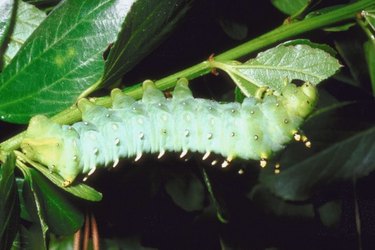Things You'll Need
Safety glasses
Gardening gloves
Long-sleeved shirt
Long pants
Mixing stick
Distilled water
2 tsp. Bacillus thuringiensis
Bucket
Garden pump sprayer

Caterpillars, which are undeveloped moths and butterflies, are prevalent pests in vegetable and flower gardens. Although caterpillars eventually evolve into butterflies, which pollinate plants, these crawling insects munch holes into plant blossoms, leaves, seedlings and buds. Large caterpillar populations can even kill or severely impede young plants. Caterpillars particularly favor leafy plants such as flat-leaf parsley, lettuce and fennel. While birds provide some biological control over caterpillar populations, serious caterpillar infestations require further, more extreme, control methods to kill the pests and protect plants.
Step 1
Prepare to apply Bacillus thuringiensis, an environmentally safe bacterial pesticide, by putting on safety gear that minimizes exposure. Wear safety glasses, gardening gloves, a long-sleeved shirt and pants. Protective gear is not required, but it is recommended.
Video of the Day
Step 2
Mix 1 gallon of distilled water with 2 tsp. of Bacillus thuringiensis in bucket. Follow the specific product's directions exactly. Bacillus thuringiensis is available through several commercialized product brands.
Step 3
Pour the Bacillus thuringiensis solution into a clean garden pump sprayer. Disperse the solution liberally onto the small caterpillars right after they start hatching from their eggs. Bacillus thuringiensis is ineffective to pupae, eggs and adult caterpillars. Apply the pesticide solution when sunlight is not bearing directly down onto the caterpillar-infested plants.
Step 4
Wait 72 hours for the Bacillus thuringiensis solution to affect the caterpillars. Although caterpillars generally quit feeding on plants within 20 minutes of consuming Bacillus thuringiensis, they sometimes take 48 to 72 hours to die. Consumption of Bacillus thuringiensis causes caterpillars to die of bacterial infection, toxemia, predation or starvation.
Step 5
Concoct a fresh mixture of Bacillus thuringiensis and water if you discover any newly hatched caterpillars in the garden. Reapply the fresh Bacillus thuringiensis solution to the caterpillars within 24 hours of the previous solution application.
Tip
Release trichogramma wasps into the garden to help control caterpillars. Trichogramma wasps consume over 200 caterpillar species.
Warning
Read the pesticide’s label to ensure Bacillus thuringiensis is safe to apply on the infested plant variety.
Chlorine in ordinary tap water destroys the bacteria in Bacillus thuringiensis, making the pesticide ineffective.
Video of the Day
- University of California Integrated Pest Management: Pests in Gardens and Landscapes - Foliage-feeding Caterpillars
- Danny Lipford; Caterpillars in the Garden; Julie Day
- "St. Petersburg Times"; The Best Caterpillar Control; John Starnes; April 2001
- Mississippi State University Division of Agriculture, Forestry and Veterinary Medicine; Farmers and Butterflies Benefit from Agricultural Buffers; Karen Brasher